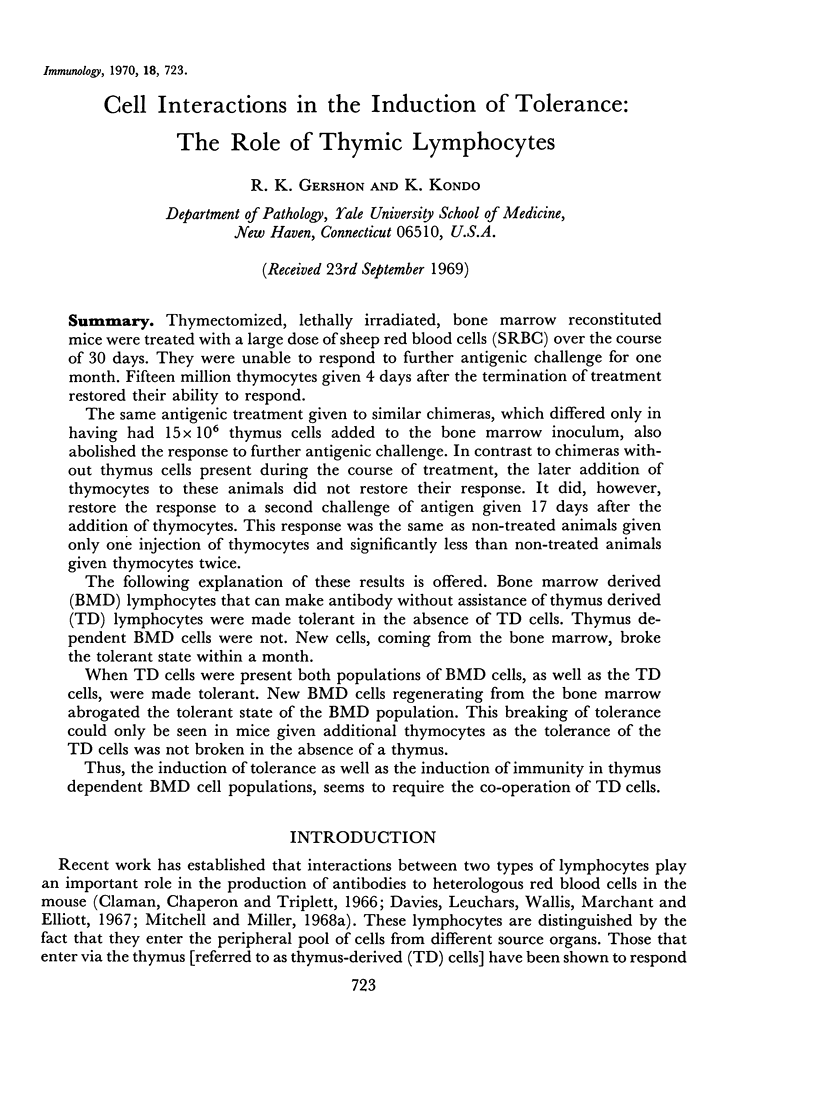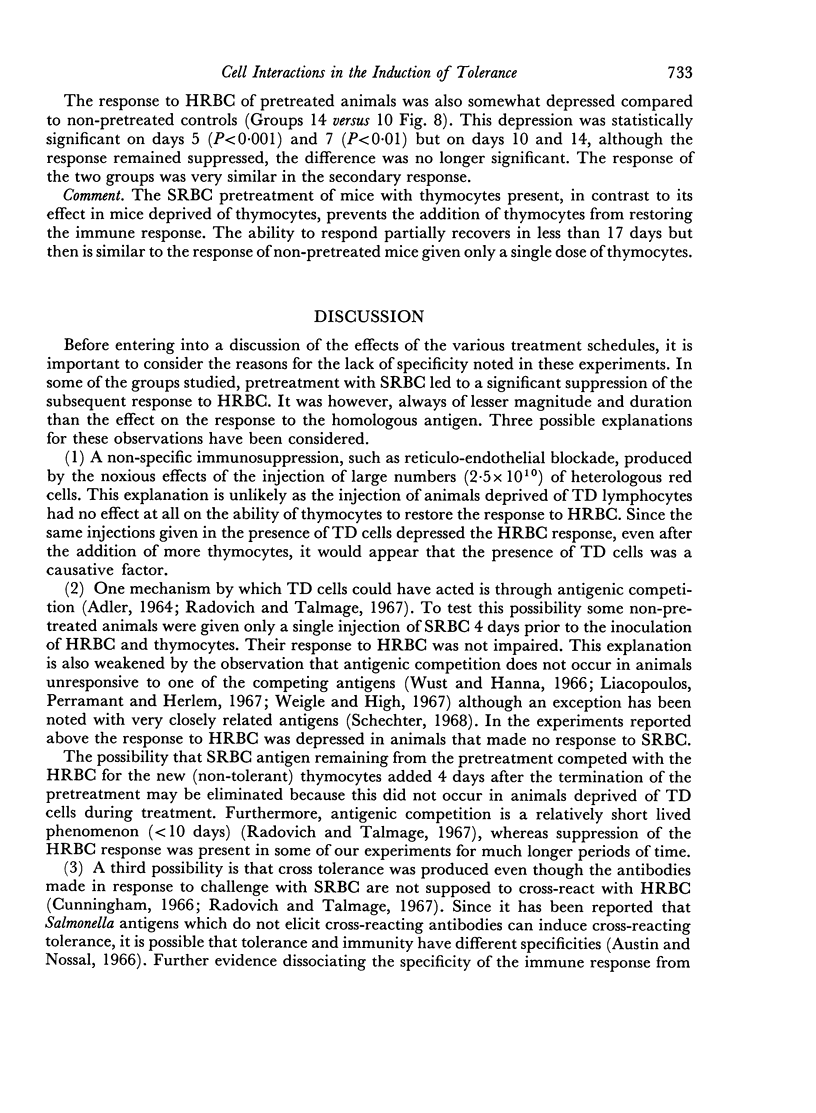Abstract
Thymectomized, lethally irradiated, bone marrow reconstituted mice were treated with a large dose of sheep red blood cells (SRBC) over the course of 30 days. They were unable to respond to further antigenic challenge for one month. Fifteen million thymocytes given 4 days after the termination of treatment restored their ability to respond.
The same antigenic treatment given to similar chimeras, which differed only in having had 15 × 106 thymus cells added to the bone marrow inoculum, also abolished the response to further antigenic challenge. In contrast to chimeras without thymus cells present during the course of treatment, the later addition of thymocytes to these animals did not restore their response. It did, however, restore the response to a second challenge of antigen given 17 days after the addition of thymocytes. This response was the same as non-treated animals given only one injection of thymocytes and significantly less than non-treated animals given thymocytes twice.
The following explanation of these results is offered. Bone marrow derived (BMD) lymphocytes that can make antibody without assistance of thymus derived (TD) lymphocytes were made tolerant in the absence of TD cells. Thymus dependent BMD cells were not. New cells, coming from the bone marrow, broke the tolerant state within a month.
When TD cells were present both populations of BMD cells, as well as the TD cells, were made tolerant. New BMD cells regenerating from the bone marrow abrogated the tolerant state of the BMD population. This breaking of tolerance could only be seen in mice given additional thymocytes as the tolerance of the TD cells was not broken in the absence of a thymus.
Thus, the induction of tolerance as well as the induction of immunity in thymus dependent BMD cell populations, seems to require the co-operation of TD cells.
Full text
PDF














Selected References
These references are in PubMed. This may not be the complete list of references from this article.
- ADLER F. L. STUDIES ON MOUSE ANTIBODIES. I. THE RESPONSE TO SHEEP RED CELLS. J Immunol. 1965 Jul;95:26–38. [PubMed] [Google Scholar]
- Abdou N. I., McKenna J. M. Immunologic studies of a spontaneous syngeneic tumor-host system. II. Specific immune tolerance and adoptive tolerance by thymic grafts. Int Arch Allergy Appl Immunol. 1968;34(6):589–596. doi: 10.1159/000230152. [DOI] [PubMed] [Google Scholar]
- Bauminger S., Sela M. Specificity of immunological tolerance to synthetic polypeptides. Isr J Med Sci. 1969 Mar-Apr;5(2):177–184. [PubMed] [Google Scholar]
- Claman H. N., Chaperon E. A., Triplett R. F. Thymus-marrow cell combinations. Synergism in antibody production. Proc Soc Exp Biol Med. 1966 Aug-Sep;122(4):1167–1171. doi: 10.3181/00379727-122-31353. [DOI] [PubMed] [Google Scholar]
- Collotti C., Leskowitz S. Immunogens and non-immunogens in the induction of tolerance. Nature. 1969 Apr 5;222(5188):97–98. doi: 10.1038/222097a0. [DOI] [PubMed] [Google Scholar]
- Cooper M. D., Gabrielsen A. E., Good R. A. Role of the thymus and other central lymphoid tissues in immunological disease. Annu Rev Med. 1967;18:113–138. doi: 10.1146/annurev.me.18.020167.000553. [DOI] [PubMed] [Google Scholar]
- Davies A. J., Leuchars E., Wallis V., Koller P. C. The mitotic response of thymus-derived cells to antigenic stimulus. Transplantation. 1966 Jul;4(4):438–451. doi: 10.1097/00007890-196607000-00008. [DOI] [PubMed] [Google Scholar]
- Davies A. J. The thymus and the cellular basis of immunity. Transplant Rev. 1969;1:43–91. doi: 10.1111/j.1600-065x.1969.tb00136.x. [DOI] [PubMed] [Google Scholar]
- Diener E., Armstrong W. D. Induction of antibody formation and tolerance in vitro to a purified protein antigen. Lancet. 1967 Dec 16;2(7529):1281–1285. doi: 10.1016/s0140-6736(67)90394-7. [DOI] [PubMed] [Google Scholar]
- Dietrich F. M., Dukor P. The immune response to heterologous red cells in mice. 3. Cyclophosphamide-induced tolerance to multispecies rd cells. Pathol Microbiol (Basel) 1967;30(6):909–917. doi: 10.1159/000161757. [DOI] [PubMed] [Google Scholar]
- Dresser D. W., Mitchison N. A. The mechanism of immunological paralysis. Adv Immunol. 1968;8:129–181. doi: 10.1016/s0065-2776(08)60466-6. [DOI] [PubMed] [Google Scholar]
- Frisch A. W., Davies G. H. Inhibition of hemagglutin synthesis by cytoxan: specificity and drug-induced "tolerance". J Lab Clin Med. 1966 Jul;68(1):103–112. [PubMed] [Google Scholar]
- Gershon R. K., Wallis V., Davies A. J., Leuchars E. Inactivation of thymus cells after multiple injections of antigen. Nature. 1968 Apr 27;218(5139):380–381. doi: 10.1038/218380a0. [DOI] [PubMed] [Google Scholar]
- Isaković K., Smith S. B., Waksman B. H. Role of the thymus in tolerance. I. Tolerance to bovine gamma globulin in thymectomized, irradiated rats grafted with thymus from tolerant donors. J Exp Med. 1965 Dec 1;122(6):1103–1123. doi: 10.1084/jem.122.6.1103. [DOI] [PMC free article] [PubMed] [Google Scholar]
- Liacopoulos P., Perramant M. F., Herlem G. Tolérance de transplantation consécutive à l'inhibition non-spécifique des réactions immunes, déterminée par l'induction de paralysie immunitaire. Pathol Biol. 1967 Apr;15(7):391–401. [PubMed] [Google Scholar]
- MILLER J. F. Studies on mouse leukaemia. The role of the thymus in leukaemogenesis by cell-free leukaemic filtrates. Br J Cancer. 1960 Mar;14:93–98. doi: 10.1038/bjc.1960.11. [DOI] [PMC free article] [PubMed] [Google Scholar]
- Micklem H. S., Ford C. E., Evans E. P., Gray J. Interrelationships of myeloid and lymphoid cells: studies with chromosome-marked cells transfused into lethally irradiated mice. Proc R Soc Lond B Biol Sci. 1966 Jul 19;165(998):78–102. doi: 10.1098/rspb.1966.0059. [DOI] [PubMed] [Google Scholar]
- Miller J. F., Mitchell G. F. Cell to cell interaction in the immune response. I. Hemolysin-forming cells in neonatally thymectomized mice reconstituted with thymus or thoracic duct lymphocytes. J Exp Med. 1968 Oct 1;128(4):801–820. doi: 10.1084/jem.128.4.801. [DOI] [PMC free article] [PubMed] [Google Scholar]
- Mishell R. I., Dutton R. W. Immunization of normal mouse spleen cell suspensions in vitro. Science. 1966 Aug 26;153(3739):1004–1006. doi: 10.1126/science.153.3739.1004. [DOI] [PubMed] [Google Scholar]
- Mitchell G. F., Miller J. F. Cell to cell interaction in the immune response. II. The source of hemolysin-forming cells in irradiated mice given bone marrow and thymus or thoracic duct lymphocytes. J Exp Med. 1968 Oct 1;128(4):821–837. doi: 10.1084/jem.128.4.821. [DOI] [PMC free article] [PubMed] [Google Scholar]
- Mitchell G. F., Miller J. F. Immunological activity of thymus and thoracic-duct lymphocytes. Proc Natl Acad Sci U S A. 1968 Jan;59(1):296–303. doi: 10.1073/pnas.59.1.296. [DOI] [PMC free article] [PubMed] [Google Scholar]
- Mitchison N. A. Immunological paralysis induced by brief exposure of cells to protein antigens. Immunology. 1968 Oct;15(4):531–547. [PMC free article] [PubMed] [Google Scholar]
- Mosier D. E. Cell interactions in the primary immune response in vitro: a requirement for specific cell clusters. J Exp Med. 1969 Feb 1;129(2):351–362. doi: 10.1084/jem.129.2.351. [DOI] [PMC free article] [PubMed] [Google Scholar]
- Owen J. J., Ritter M. A. Tissue interaction in the development of thymus lymphocytes. J Exp Med. 1969 Feb 1;129(2):431–442. doi: 10.1084/jem.129.2.431. [DOI] [PMC free article] [PubMed] [Google Scholar]
- Paul W. E., Thorbecke G. J., Siskind G. W., Benacerraf B. The effect of dose in tolerance induction on the subsequent response to a cross-reactive antigen. Immunology. 1969 Jul;17(1):85–92. [PMC free article] [PubMed] [Google Scholar]
- Radovich J., Talmage D. W. Antigenic competition: cellular or humoral. Science. 1967 Oct 27;158(3800):512–514. doi: 10.1126/science.158.3800.512. [DOI] [PubMed] [Google Scholar]
- SEVER J. L. Application of a microtechnique to viral serological investigations. J Immunol. 1962 Mar;88:320–329. [PubMed] [Google Scholar]
- Schechter I. Antigenic competition between polypeptidyl determinants in normal and tolerant rabbits. J Exp Med. 1968 Feb 1;127(2):237–250. doi: 10.1084/jem.127.2.237. [DOI] [PMC free article] [PubMed] [Google Scholar]
- Scott D. W., Gershon R. K. Determination of total and merecaptothanol-resistant antibody in the same serum sample. Clin Exp Immunol. 1970 Feb;6(2):313–316. [PMC free article] [PubMed] [Google Scholar]
- Scott D. W., Waksman B. H. Mechanism of immunologic tolerance. I. Induction of tolerance to bovine gamma-globulin by injection of antigen into intact organs in vitro. J Immunol. 1969 Feb;102(2):347–354. [PubMed] [Google Scholar]
- Taylor R. B. Cellular cooperation in the antibody response of mice to two serum albumins: specific function of thymus cells. Transplant Rev. 1969;1:114–149. doi: 10.1111/j.1600-065x.1969.tb00138.x. [DOI] [PubMed] [Google Scholar]
- Taylor R. B. Immune paralysis of thymus cells by bovine serum albumin. Nature. 1968 Nov 9;220(5167):611–611. doi: 10.1038/220611a0. [DOI] [PubMed] [Google Scholar]
- Weigle W. O., High G. J. The effect of antigenic competition on antibody production to heterologous proteins, termination of immunologic unresponsiveness and induction of autoimmunity. J Immunol. 1967 Aug;99(2):392–398. [PubMed] [Google Scholar]


